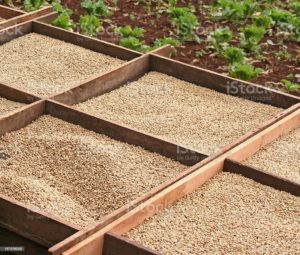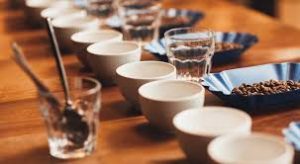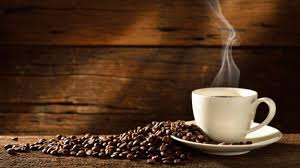10 Steps from Seed to Cup
The coffee you enjoy each day has taken a long journey to arrive in your cup.
Between the time they’re planted, picked and purchased, coffee beans go through a typical series of steps to bring out their best.
1. Planting

A coffee bean is actually a seed. When dried, roasted and ground, it’s used to brew coffee. If the seed isn’t processed, it can be planted and grow into a coffee tree.
Coffee seeds are generally planted in large beds in shaded nurseries. The seedlings will be watered frequently and shaded from bright sunlight until they are hearty enough to be permanently planted. Planting often takes place during the wet season, so that the soil remains moist while the roots become firmly established.
2. Harvesting the Cherries
Traditionally coffee is harvested by hand by one of two ways: strip picking or selective picking. Strip picking is exactly how it sounds, trees are harvested entirely at one time “stripping” all the beans off the branches, ripe as well as unripe cherries. Typically, only Robusta coffee is strip picked.
Depending on the variety, it will take approximately 3 to 4 years for the newly planted coffee trees to bear fruit. The fruit, called the coffee cherry, turns a bright, deep red when it is ripe and ready to be harvested.
There is typically one major harvest a year. In countries like Colombia, where there are two flowerings annually, there is a main and secondary crop.
In most countries, the crop is picked by hand in a labor-intensive and difficult process, though in places like Brazil where the landscape is relatively flat and the coffee fields immense, the process has been mechanized. Whether by hand or by machine, all coffee is harvested in one of two ways:
Strip Picked: All of the cherries are stripped off of the branch at one time, either by machine or by hand.
Selectively Picked: Only the ripe cherries are harvested, and they are picked individually by hand. Pickers rotate among the trees every eight to 10 days, choosing only the cherries which are at the peak of ripeness. Because this kind of harvest is labor intensive and more costly, it is used primarily to harvest the finer Arabica beans.
A good picker averages approximately 100 to 200 pounds of coffee cherries a day, which will produce 20 to 40 pounds of coffee beans. Each worker’s daily haul is carefully weighed, and each picker is paid on the merit of his or her work. The day’s harvest is then transported to the processing plant.
3. Processing the Cherries

Once the coffee has been picked, processing must begin as quickly as possible to prevent fruit spoilage. Depending on location and local resources, coffee is processed in one of two ways:
The Dry Method is the age-old method of processing coffee, and still used in many countries where water resources are limited. The freshly picked cherries are simply spread out on huge surfaces to dry in the sun. In order to prevent the cherries from spoiling, they are raked and turned throughout the day, then covered at night or during rain to prevent them from getting wet. Depending on the weather, this process might continue for several weeks for each batch of coffee until the moisture content of the cherries drops to 11%.
The Wet Method removes the pulp from the coffee cherry after harvesting so the bean is dried with only the parchment skin left on. First, the freshly harvested cherries are passed through a pulping machine to separate the skin and pulp from the bean.
Then the beans are separated by weight as they pass through water channels. The lighter beans float to the top, while the heavier ripe beans sink to the bottom. They are passed through a series of rotating drums which separate them by size.
After separation, the beans are transported to large, water-filled fermentation tanks. Depending on a combination of factors — such as the condition of the beans, the climate and the altitude — they will remain in these tanks for anywhere from 12 to 48 hours to remove the slick layer of mucilage (called the parenchyma) that is still attached to the parchment. While resting in the tanks, naturally occurring enzymes will cause this layer to dissolve.
When fermentation is complete, the beans feel rough to the touch. The beans are rinsed by going through additional water channels, and are ready for drying.
4. Drying the Beans

If the beans have been processed by the wet method, the pulped and fermented beans must now be dried to approximately 11% moisture to properly prepare them for storage.
These beans, still inside the parchment envelope (the endocarp), can be sun-dried by spreading them on drying tables or floors, where they are turned regularly, or they can be machine-dried in large tumblers. The dried beans are known as parchment coffee, and are warehoused in jute or sisal bags until they are readied for export.
5. Milling the Beans

Before being exported, parchment coffee is processed in the following manner:
Hulling machinery removes the parchment layer (endocarp) from wet processed coffee. Hulling dry processed coffee refers to removing the entire dried husk — the exocarp, mesocarp and endocarp — of the dried cherries.
Polishing is an optional process where any silver skin that remains on the beans after hulling is removed by machine. While polished beans are considered superior to unpolished ones, in reality, there is little difference between the two.
Grading and Sorting is done by size and weight, and beans are also reviewed for color flaws or other imperfections.
Beans are sized by being passed through a series of screens. They are also sorted pneumatically by using an air jet to separate heavy from light beans.
Typically, the bean size is represented on a scale of 10 to 20. The number represents the size of a round hole’s diameter in terms of 1/64’s of an inch. A number 10 bean would be the approximate size of a hole in a diameter of 10/64 of an inch, and a number 15 bean, 15/64 of an inch.
Finally, defective beans are removed either by hand or by machinery. Beans that are unsatisfactory due to deficiencies (unacceptable size or color, over-fermented beans, insect-damaged, unhulled) are removed. In many countries, this process is done both by machine and by hand, ensuring that only the finest quality coffee beans are exported.
6. Exporting the Beans




The milled beans, now referred to as green coffee, are loaded onto ships in either jute or sisal bags loaded in shipping containers, or bulk-shipped inside plastic-lined containers.
7. Tasting the Coffee


Coffee is repeatedly tested for quality and taste. This process is referred to as cupping and usually takes place in a room specifically designed to facilitate the process.
- First, the taster — usually called the copper — evaluates the beans for their overall visual quality. The beans are then roasted in a small laboratory roaster, immediately ground and infused in boiling water with carefully-controlled temperature. The cupper noses the brew to experience its aroma, an essential step in judging the coffee’s quality.
- After letting the coffee rest for several minutes, the cupper breaks the crust by pushing aside the grounds at the top of the cup. Again, the coffee is nosed before the tasting begins.
- To taste the coffee, the cupper slurps a spoonful with a quick inhalation. The objective is to spray the coffee evenly over the cupper’s taste buds, and then weigh it on the tongue before spitting it out.
Samples from a variety of batches and different beans are tasted daily. Coffees are not only analyzed to determine their characteristics and flaws, but also for the purpose of blending different beans or creating the proper roast. An expert copper can taste hundreds of samples of coffee a day and still taste the subtle differences between them.
8. Roasting the Coffee



Roasting transforms green coffee into the aromatic brown beans that we purchase in our favorite stores or cafés. Most roasting machines maintain a temperature of about 550 degrees Fahrenheit. The beans are kept moving throughout the entire process to keep them from burning.
When they reach an internal temperature of about 400 degrees Fahrenheit, they begin to turn brown and the caffeol, a fragrant oil locked inside the beans, begins to emerge. This process called pyrolysis is at the heart of roasting — it produces the flavor and aroma of the coffee we drink.
After roasting, the beans are immediately cooled either by air or water. Roasting is generally performed in the importing countries because freshly roasted beans must reach the consumer as quickly as possible.
9. Grinding Coffee



The objective of a proper grind is to get the most flavor in a cup of coffee. How coarse or fine the coffee is ground depends on the brewing method.
The length of time the grounds will be in contact with water determines the ideal grade of grind Generally, the finer the grind, the more quickly the coffee should be prepared. That’s why coffee ground for an espresso machine is much finer than coffee brewed in a drip system.
Espresso machines use 132 pounds per square inch of pressure to extract coffee.
We recommend taking a moment to examine the beans and smell their aroma
10. Brewing Coffee
To master how to brew coffee, use our guide for tips and methods on how to make the perfect cup for any preference. Enjoy
! 



Perfectly pent subject material, Really enjoyed studying.
Greetings! Quick question that’s totally off topic. Do you know how to make your site mobile friendly? My site looks weird when viewing from my apple iphone. I’m trying to find a template or plugin that might be able to correct this issue. If you have any suggestions, please share. Appreciate it!
Very efficiently written post. It will be useful to anyone who usess it, as well as myself. Keep doing what you are doing – for sure i will check out more posts.
Your place is valueble for me. Thanks!…
Thankyou for this tremendous post, I am glad I noticed this internet site on yahoo.
I like this blog very much so much wonderful info .
You really make it appear really easy together with your presentation however I in finding this topic to be really something which I believe I’d never understand. It sort of feels too complicated and very vast for me. I’m taking a look ahead in your next post, I?¦ll try to get the grasp of it!
I?¦ve been exploring for a bit for any high quality articles or blog posts in this kind of space . Exploring in Yahoo I eventually stumbled upon this site. Studying this info So i am happy to exhibit that I’ve an incredibly just right uncanny feeling I came upon exactly what I needed. I so much no doubt will make sure to do not put out of your mind this website and give it a glance regularly.
I was curious if you ever thought of changing the structure of your website? Its very well written; I love what youve got to say. But maybe you could a little more in the way of content so people could connect with it better. Youve got an awful lot of text for only having one or 2 pictures. Maybe you could space it out better?
I have read some excellent stuff here. Certainly value bookmarking for revisiting. I wonder how so much attempt you place to create this type of magnificent informative web site.
Currently it looks like Movable Type is the best blogging platform out there right now. (from what I’ve read) Is that what you are using on your blog?
Nice read, I just passed this onto a friend who was doing a little research on that. And he actually bought me lunch since I found it for him smile Thus let me rephrase that: Thanks for lunch! “Bill Dickey is learning me his experience.” by Lawrence Peter Berra.
I needed to create you that bit of word to be able to give thanks as before for your gorgeous solutions you’ve discussed on this site. It’s simply pretty generous of you to allow openly just what many of us could possibly have distributed for an ebook to make some cash on their own, mostly since you might have done it in the event you considered necessary. These good tips also worked to provide a fantastic way to realize that other people online have the same fervor like mine to grasp significantly more around this matter. I am certain there are some more enjoyable occasions in the future for individuals who discover your blog post.
Hey there would you mind sharing which blog platform you’re using? I’m going to start my own blog in the near future but I’m having a difficult time deciding between BlogEngine/Wordpress/B2evolution and Drupal. The reason I ask is because your design seems different then most blogs and I’m looking for something unique. P.S Apologies for getting off-topic but I had to ask!
Thanks for every other informative blog. The place else may I get that type of info written in such an ideal approach? I have a venture that I am just now working on, and I have been on the look out for such information.
nv2898
7zdv3p
You really make it appear so easy along with your presentation but I to find this matter to be actually one thing which I feel I would by no means understand. It kind of feels too complex and very broad for me. I’m looking forward on your subsequent publish, I?¦ll attempt to get the hang of it!
Respect to author, some fantastic entropy.
6mhwf6
I like this site very much so much good information.
Great blog! Is your theme custom made or did you download it from somewhere? A theme like yours with a few simple adjustements would really make my blog stand out. Please let me know where you got your theme. Kudos
Hello, i feel that i noticed you visited my web site so i came to “go back the want”.I am attempting to in finding things to enhance my website!I suppose its ok to make use of some of your ideas!!
lCksXPi AZVJ kHiGgN lKtKNgQ kVLyiEq
Very good https://lc.cx/xjXBQT
rwntvp
Awesome https://t.ly/tndaA
Very good https://is.gd/N1ikS2
услуги по продаже аккаунтов маркетплейс аккаунтов
гарантия при продаже аккаунтов аккаунт для рекламы
маркетплейс для реселлеров маркетплейс аккаунтов
продать аккаунт продажа аккаунтов соцсетей
Awesome https://is.gd/N1ikS2
купить аккаунт перепродажа аккаунтов
купить аккаунт аккаунты с балансом
маркетплейс аккаунтов маркетплейс аккаунтов соцсетей
Awesome https://is.gd/N1ikS2
магазин аккаунтов социальных сетей магазин аккаунтов
покупка аккаунтов магазин аккаунтов социальных сетей
продать аккаунт гарантия при продаже аккаунтов
маркетплейс аккаунтов соцсетей купить аккаунт
маркетплейс аккаунтов покупка аккаунтов
аккаунты с балансом https://kupit-akkaunt-top.ru/
услуги по продаже аккаунтов продажа аккаунтов
Привет любителям новых идей!
Попробуйте нейросеть, которая заменит десяток приложений: чат GPT для физической активности — тренировки при сколиозе, отслеживание потребления воды; для музыкантов — тексты песен в стиле Billie Eilish; для сохранителей природы — анализ углеродного следа. Чат GPT сказки — генерация сказок на ночь с персональными персонажами. Используйте все возможности ИИ — сразу и без регистрации!
Узнать больше – https://yarchatgpt.ru
что может gpt chat
Ваши идеи достойны реализации!
Account Catalog Account Trading Platform
Website for Buying Accounts Online Account Store
me encantei com este site. Para saber mais detalhes acesse nosso site e descubra mais. Todas as informações contidas são informações relevantes e exclusivas. Tudo que você precisa saber está está lá.
продать аккаунт https://akkaunt-magazin.online/
купить аккаунт https://akkaunty-optom.live
продажа аккаунтов https://online-akkaunty-magazin.xyz
магазин аккаунтов https://akkaunty-dlya-prodazhi.pro/
биржа аккаунтов kupit-akkaunt.online
buy a facebook account https://buy-adsaccounts.work
buy facebook profile https://buy-ad-accounts.click
buy fb account facebook account buy
buy old facebook account for ads https://buy-ads-account.click
Hmm is anyone else experiencing problems with the images on this blog loading? I’m trying to figure out if its a problem on my end or if it’s the blog. Any feed-back would be greatly appreciated.
https://shorturl.fm/bODKa
https://shorturl.fm/m8ueY
https://shorturl.fm/bODKa
https://shorturl.fm/XIZGD
https://shorturl.fm/A5ni8
https://shorturl.fm/oYjg5
https://shorturl.fm/bODKa
https://shorturl.fm/XIZGD
https://shorturl.fm/m8ueY
https://shorturl.fm/a0B2m
https://shorturl.fm/TbTre
https://shorturl.fm/YvSxU
https://shorturl.fm/FIJkD
https://shorturl.fm/5JO3e
https://shorturl.fm/YvSxU
https://shorturl.fm/uyMvT
https://shorturl.fm/I3T8M
https://shorturl.fm/Kp34g
https://shorturl.fm/nqe5E
https://shorturl.fm/VeYJe
https://shorturl.fm/fSv4z
https://shorturl.fm/PFOiP
https://shorturl.fm/YZRz9
https://shorturl.fm/0EtO1
https://shorturl.fm/hevfE
Just tried out Sprunki Game and it’s a fresh twist on Incredibox-easy to pick up but deep enough to keep you creating for hours. Love the new beats and visuals!
Good day! Do you use Twitter? I’d like to follow you if that would be okay. I’m undoubtedly enjoying your blog and look forward to new posts.